 |
[ Outlaw Genealogy | Bruce
History | Lost Chords ] [ Projects | News | FAQ | Suggestions | Search | HotLinks | Resources | Ufo ] |
 |
[ Outlaw Genealogy | Bruce
History | Lost Chords ] [ Projects | News | FAQ | Suggestions | Search | HotLinks | Resources | Ufo ] |
Noticed that not all the document links to the Margam Abbey - Bristol were linked:
Notice that although the records were found with Margam's Abbey , the original agreement was with Saint James Priory that then in turn donated the land to Margam Abbey. This seems to be the original link to Earl of Gloucester and the invasion of Ireland:
A history of Margam Abbey - Possessions of the Abbey in the towns of Bristol and Cardiff
1210~ - Margam Abbey - John, son of Ralph Utlage, of the land in the meadow of Leowine, known as Lewin's-mead, near to St. James' Church, Bristol. - dated in the early years of the thirteenth century.
| - - - -
1186~1202 - Confirmation
by the Prior of St. James's, Bristol, to John, son of Ralph
Utlage, of land in Lewin's Mead
1200~1210 - Grant
by the Prior of St. James's, Bristol, to Margam Abbey, of land in Lewin's
Mead, Bristol, Formerly held by John, son of Ralph le Utlage
1186~1202:
Cartae et alia munimenta quae ad dominium de Glamorgancia pertinent
Page 256:
CCLVI.
CONFIRMATION BY THE PRIOR OF ST. JAME'S, BRISTOL, TO JOHN, SON
OF RALPH UTLAGE, OF LAND IN LEWIN'S MEAD.
[Margam Charter.]
Sciant p. et f. quod ego W. prior ecclesie Santi Jacobi de Brist[ollia] et
fratres ejusdem loci . auetoritate et concessu venerabilis patris nostri Alani
abbatis Theokesbirie et ejusdem loci eonventus . concessimus . et hac carta
confiimavimus . Johanni filio Radulphi Utlage . totam terram illam in prato
Leowini . quam Radulphus pater suus emit de Ailwardo textore. Tenendam
et habendam predictam terram de ecelesia beati Jacobi sibi et heredibus suis .
libere et quiete hereditabiliter . reddendo inde annuatim ecclesie Sancti Jacobi .
XII. denarios ad festum Sancti Michaelis . pro omni servitio et exactione. Et in
mutatione heredum heredes sui dabunt ecclesie Sancti Jacobi . dimidiam libram
piperis de recognitione. Quod ut ratum et stabile permaneat . presentem cartam
sigilli nostri appositione roboravimus. Hiis testibus.
Entitled—' Carta ejusdem de eodem.'
' Pratum Leowini ' is Lewin's Mead, near to St. Jame's Church in Briatol.
The pound of pepper payable on change of heir is a very early example of
heriot.
| - - - -
They must know that p. and f. I W. prior of St. James of Bristol, and the brethren of that place authority and the retirement of our venerable father, Alan Theokesbirie [ Tewkesbury ] abbot and convent of that place granted and confirmed this Charter. John, son of Ralph Outlawe. Leowini the whole of that land in the meadow. Ralph his father had bought from the Ailwardo weaver. Hold and to have the said land of the church of the blessed James to himself and to his heirs. freely and heritably. an annual payment of the church of St James. 12. pence on the feast of St. Michael. for all service and exaction. And in a change of the heirs of his heirs, they shall give to the church of St James half a pound of pepper on the acknowledgment. As approved remain firm and stable. by the strength of the present charter of the placing of our seal.. These being witnesses.
The charter of the same.
CCLVII.
GRANT BY THE PRIOR OF ST. JAMES'S, BRISTOL, TO MARGAM ABBEY, OF LAND IN LEWIN'S
MEAD, BRISTOL, FORMERLY
HELD BY JOHN, SON OF RALPH LE UTLAGE.
[Margam Charter.]
Sciant presentes et futuri . quod ego . W. dictus prior Sancti Jacobi de
Brist[ollia] et monachi ibidem Deo servientes . concessimus et hac presenti carta
nostra confirmavimus ecclesie beate Marie de Margan . et conventui ejusdem
loci . quaudam terram in prato Leowini . illam scilicet quam Johannes filius
Radulphi le Utlage de nobis tenuit . quam etiam de dono Henrici Cumin
habuimus. Tenendam et habendam predictam terram prediote ecclesie et ejusdem
loci conventui . de nobis et successoribus nostris in perpetuum . reddendo inde
annuatim . uobis et sucoessoribus nostris xii. denarios ad festum Sancti Michaelis
pro omni servitio. Quod ut magis ratum sit et inconoussum . presens scriptum
sigilli nostri appositione dignum duximus confirmandum.
Entitled— ' Cyrographum Prioris Sancti Jacobi de terra Utlage.'
Know all present and future. what I want. W. the said prior of Saint James in Bristol and the monks serving God there granted, and by this our present charter confirmed to the church of blessed Mary of Margan and the convent of that place. quaudam Leowini land in the meadow. namely, that which John the son of Ralph Outlawe of held of us. Also we have had of the gift of Henry Cumin to Hold and to have the aforesaid land to the aforesaid church and of the same place for the meeting of us and our successors for ever. an annual payment. us and our successors of the Twelve. pence at the feast of the Holy Michael for all service. In order to be valid and unchanged for more. the present writing shall have thought fit to encourage the placing of our seal.
Chirograph Prior of St. James of Outlawe
| = = = = =
Heriot
Latin, herietum.
Heriot means 'war gear', a death
duty paid
by the higher nobility in Anglo-Saxon England. It took the form of the
'return' of the weapons and horses with which a lord was presumed to have
endowed his man when the bond between them was forged. Heriots were paid right
up to the Conquest, a strong indication of the continuing military ethos of the
Anglo-Saxon nobility down to 1066. In the late Anglo-Saxon period, a tariff was
enshrined in the laws of King Canute. According to this code, for example, the
heriot of an earl was eight horses - four saddled and four unsaddled - four mail
coats, four helmets, eight spears, eight shields, four swords, and a substantial
payment in gold. In other words, the war gear for four fully-equipped warriors
and their attendants. Heriots could be commuted to cash payments, and often were
for the lesser nobility; Domesday Book records several examples.
As a death duty, heriots could be confused with reliefs,
which strictly speaking were inheritance taxes rather than a death duties. After
the Conquest, death duties and inheritance taxes became fused, and relief
superseded heriots as far as the nobility was concerned.
Relief
Latin, relevatio.
The relief was a payment offered by an heir to an overlord for the right to
succeed to an estate. As such, it could be confused with the heriot,
a death
duty rather
than an inheritance tax. Domesday Book does confuse the two on occasions, as did
other contemporary sources. In part, this is due to an inherent ambiguity
between a death duty and an inheritance tax, both being succession payments in
fact if not in name or origin.
After the Conquest, in fact, the two were fused. Thereafter, succession dues
paid by peasantry were generally known as heriots, those by the aristocracy as
reliefs. Reliefs also appear to have become more onerous after the Conquest.
As early as the reigns of the Conqueror's two sons, they were politically
charged issues, so much so that on his coronation Henry I felt obliged to
renounce the arbitrary sums levied by his brother and content himself with 'just
and lawful reliefs'. They remained, however, a major source of grievance down to
Magna Carta.
St James Priory - ST JAMES PRIORY IS THE OLDEST BUILDING IN BRISTOL.
Explore the fascinating history and heritage of St James Priory – the oldest building in Bristol still in use today.
Robert Fitzroy, Earl of Gloucester and illegitimate grandson of William the Conqueror, founded the Priory of St James in
1129. It has been used as a place of worship for 900 years.
In the medieval period, St James Priory was home to Benedictine monks. They lived here as a community of brothers, devoting their lives to worshipping God and caring for the poor and the sick. The Priory was dissolved during the reign of Henry VIII, and many of its buildings were demolished. Only the west end survived as a smaller parish church, and is still used for worship today.
Now, St James Priory provides residential support and treatment for people suffering from substance addiction and/or homelessness
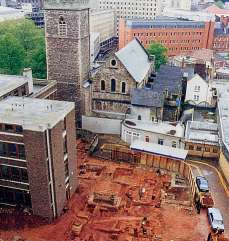 Excavations
at St James Priory
Excavations
at St James Priory
Bristol’s oldest building is now home to Bristol’s newest cafe. The twelfth-century St James’ Priory, tucked away behind the bus station, recently reopened after a £3.5 million renovation and repair
project. Last week, Cafe Refectoire opened its doors for the first time, a lovely little cafe and a much-needed new revenue scheme for the continued maintenance of St James’.
Situated in the east entrance of the priory – in medieval times home to Benedictine monks, now an addiction centre – Cafe Refectoire is situated in a new addition next to the 1129 building. Inside, there are a couple of tables next to a glass screen through which you can see the church where mass is still celebrated every Sunday.
Line drawing of 1799 plan of Lewins Mead & St John's Bridge area of Bristol [BRO 36772 Box 12]
| - - - - - - -
Lewin's Mead - The Changing Face of Bristol
Lewin's Mead BS1 - a set on Flickr
| - - - -
Memoirs historical and topographical of Bristol and it's neighbourhood - Vol I
Before John's marriage with Isabella could be solemnized, the earl of Gloucester died. "Earl William dyed (f) in Brightestow" "castel, and willed to be buried with his father at St James; but he was Privately conveyed by night unto Cainsham, to which he had given the whole lordship of Marschefel, and impropriated the benefice thereof unto St James's Priory; and the benefice consequently came to Theokesbyri [ Tewkesbury !!! ] . [ There was as it is said, a nunnery at Marschefeide ]
The anonymous historian of that Abbey in Dugdale (g) places his death under the year mclcxiij, and so does the authour quoted by Leland (h): these two however are really but one authority, and it is manifestly an error (one x being omitted) because his transactions in 1175 and 1176 have been just mentioned. The Annals of Waverley are as follows. "William, earl of Glocester died AD 1183, on the same night on which he was born, that is on the night of St Clement[Nov' 23] which is no doubt correct. His large seal is 2£ inches in diameter, having a Tiger («) passant before a tall upright plant.
One of his Deeds, which conveys land in Lewins-mead and Broad-mead, has something observable. It is as follows, copied from two coeval patterns: the brackets contain the differences of one from the other.
[omnibus amicis et fidelibus hominibus suis de Bruist' salutem]- Notum sit vobis, me dedisse et concessisse Roberto fil' Suein et Christians uxori ejus et eorum heredibus, tcrram et domum quas Blachemannus [Blakemannus] tenet de me in feria [feira] dc Brist', et terrain et domum, quas Lefwinus [Lewinus] (A:) Lari tenet de me in feria [feira] de Bruist' [Brist']; et tcrram & domum quas Hugo Margam [Morgon] tenet de me in feria [feira] dc Bruist' [Brist']; et illam longam domum & terram, quae est juxta domum Will' Traine in feria de Brist' [in feira de Bruist']; et servicium Willelmi de Hereford [Herefort] de terra quam de me tenet in saepe dicta feria [feira], scilicet unam libram cumini per annum. Testibus Magistro Moise, nepote meo; Waltero Clerico; Willelmo capellano; Roberto fil' Osb'; Elia de Hintana [Hinetuna]; Roberto de Paris; Roberto de Penedoc; Waltero Hachat [Hacat]; Petro Camerario."
[Bruist of his men and to the faithful to all his friends 'salvation] - Be it known to you, that I have given and granted to Robert son of Suein and Christine his wife and their heirs, and the house of which the land Blachemannus [Blakemannus] he holds of me in the day of the week [feira] dc bright ', and land and house, which Lefwinus [Lewin] (A :) hold of me as the months go on a weekday [feira] of Bruist' [bright '], and house and land which Hugh mass in b minor [Morgon] holds of me in the day [feira] dc Bruist '[bright'], and of a long house and land, which is near the house of Will 'Train the day of the bright' [in the feira of Bruist ']; and service of William of Hereford [Herefort] from the land of which I have been said to hold in the day [feira], namely, one pound of cumin a year. Witnesses, Master Moses, my nephew, Walter Clerke, William, chaplain, son of Robert "OSB" Elijah of Hintana [Hinetuna] Robert of Paris, Robert Penedoc; Walter Hachat [Hacat] Peter Chamberlain. "
| - - -
Full text of Journal of the British Archaeological Association
...
No. 174. Grant by Adam de Hel', clerk of the Earl of Gloucester, to
Robert, son of Swein, of various lands and houses held by Blakcman,
Lewinus Lari, and Hugo Margan, from the market of Bristol, and a long house and land next
to the house of William Traine in the market, etc.
The text is much mutilated, but I am enabled to restore it from parallel passages in the next deed.
| - - -
ROBERT FITZ SUEIN has an unknown birthdate. He married GUNNOR BIGOD
HENRY2 FITZ SUEIN, b. in Essex, England, United Kingdom;
AGNES3
FITZ SUEIN (Henry2,
Robert1),
daughter of (2) Henry2
and Cicely (_____) FITZ SUEIN, was
born between 1109 and 1149, and died between 1164 and 1259. She married in
1162/3, (AQB-4) AUBREY
DE VERE, 1ST
EARL OF OXFORD,
son of (AQB-2) Aubrey
II and (O-7) Alice
(de CLARE), who died on 26 Dec. 1194[1].
Child: See (AQB-4) Aubrey
de VERE, 1st Earl of Oxford
Probably the person from whom Lewins-mead takes it's name. [ Lewinus Lari ]
Journal of the British Archaeological Association - British Archaeological Association
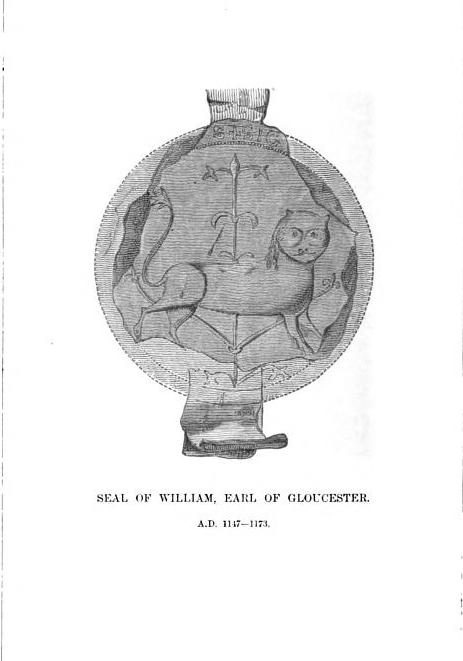 To this early charter, of the twelfth century, is appended a fine oval gem
seal, bearing a figure of Fortune holding a Victory and branch. The legend is
Sigillvm Adam De Hel'. - 1147 -
1173
To this early charter, of the twelfth century, is appended a fine oval gem
seal, bearing a figure of Fortune holding a Victory and branch. The legend is
Sigillvm Adam De Hel'. - 1147 -
1173
. Grant by Adam de Heli, clerk of the Earl of Gloucester, to Robert, son of Swein, of various lands and houses held by Blakeman, Lewinus Lari, and Hugo Margan, from the market of Bristol, and a long house and land next to the house of William Traine in the market, etc. The text is much mutilated, but I am enabled to restore it from parallel passages in the next deed.
No. 177. Grant by William, Earl of Gloucester, to the monks of St. James, Bristol, of the tenth penny of his mill at'Rumia. (See plate.)
Bristol, a historical and topographical account of the city - Alfred Harvey
...
Beginning at the south-west was the great Augustinian abbey, already described, and next, on the same knoll and only separated by College Green, came the Gaunts' Hospital, beyond which was the small house of Carmelites, the gardens of the two joining.
Beyond and lower down, but with its grounds stretching high up the hillside, was the important friary of Franciscans in Lewin's
Mead; and beyond this again, and standing a little higher up the hill, was the one foundation for Benedictine monks, the priory of St. James, built by the great Earl
Robert.
On the high ground above the two last there was a small convent of Benedictine nuns on St. Michael's Hill; and lastly, the semicircle was completed by the house of the Black or Dominican Friars, higher up the river, but occupying a low-lying situation beneath the shadow of the castle, at the east end of the town. Besides these there were hospitals which were to some extent religious foundations : the early St. Bartholomew's, near the Franciscan Friary, just outside the north gate, and the more recent, though still mediaeval, Foster's Almshouses on St. Michael's Hill, with a pretty Late Gothic chapel bearing the rare dedication to the Three Kings of Cologne; and lastly, beyond the ring and well removed from the populous town, there was a small hospital, perhaps two, for lepers, near the ford through the Frome, known as Lawford's Gate. On the south side of the Avon, too, there were some three or four religious houses, all small and unimportant, and now quite demolished.
The abbey of St. Augustine has already been described; of the others the earliest in date, and
perhaps the most important, was the Benedictine priory of St. James, founded by Robert, Earl of
Gloucester, early in the reign of Stephen, or in the closing years of that of Henry
I. It was never an independent house, but was a cell to the abbey of Tewkesbury, of which the earl was a great benefactor, as the son-in-law of its founder. It is said that
one tenth of the Caen stone imported for the building of the castle was devoted to the erection of the priory. Earl Robert endowed his foundation with the manor of Esselega, now Ashley, a northern suburb of Bristol, the tithes of various rents, all churches of his fee in Cornwall, and one church beyond the sea, that of Escrimoville, in Normandy. In addition he gave it the profits of a Whitsuntide fair held in the great open space in front of the priory, and the prior had also the prisage of all wines brought into the port of Bristol during the octave of St. James; the two last benefactions proved to be the source of much subsequent litigation.
The founder, who died October 31, 1147, was buried in the centre of the choir of the church, in a tomb of green jasper, which has entirely disappeared;
If Alan died in 1202 then we know that this first contract was at least before 1202: so when was he in town? St. Thomas Becket died in 1170 and Alan is removed to Tewkesbury in 1186 - So that gives a date between 1186 and 1202.
So when did Ralph Outlawe buy the land from Ailwardo the weaver ? I doubt we will ever know.
They must know that p. and f. I W. prior of St. James of Bristol, and the brethren of that place authority and the retirement of our venerable father, Alan Theokesbirie [ Tewkesbury ] abbot and convent of that place granted and confirmed this Charter. John, son of Ralph Outlawe. Leowini the whole of that land in the meadow. Ralph his father had bought from the Ailwardo weaver. Hold and to have the said land of the church of the blessed James to himself and to his heirs. freely and heritably. an annual payment of the church of St James. 12. pence on the feast of St. Michael. for all service and exaction. And in a change of the heirs of his heirs, they shall give to the church of St James half a pound of pepper on the acknowledgment. As approved remain firm and stable. by the strength of the present charter of the placing of our seal.. These being witnesses.
Alan of Tewkesbury - A Benedictine abbot and writer, d. 1202. Alan is stated by Gervase of Canterbury, a contemporary; chronicler, to have been English by race, i.e. not of Norman, or any immigrant, extraction. He is supposed to have spent some years at Benevento in Italy, before entering the Benedictine novitiate at Canterbury, where he became Prior in 1179. He zealously espoused the cause of the clergy against Henry II in the struggle which led to the martyrdom of St. Thomas; He was removed from Canterbury to the Abbey of; Tewkesbury, where he could less effectively oppose Henry's encroachments on the rights of the church; The intimacy with St. Thomas which Alan of Tewkesbury enjoyed, and his almost lifelong acquaintance with the politico-ecclesiastical controversies of the time, qualified him to write the "Life of St. Thomas", which (as Life of Becket) is printed in the second volume of "Materials for the History of Thomas Becket", edited by the Rev. J.C. Robertson (Rolls Series, London,; 1875-85; Part I, CXC, 1475-88). Alan also collected and arranged a number of the Saint's epistles. Critics are doubtful as to the genuineness of the other works traditionally ascribed to him.
Archbishop Baldwin, who succeeded Richard in 1184, was a Cistercian monk and a scholar, and did not look favourably upon the luxury, independence, and ignorance of the chapter. Urged probably by the clerks around him, he planned a large collegiate church, to be maintained out of the property of the see; and obtained from Lucius III permission to recover the estates alienated to the convent by his predecessor, of which the principal were the oblations, belonging canonically to the archbishop, and the churches of Monkton, Eastry, Meopham, and Eynsford; and began proceedings by confiscating the xenia on 15 December, 1185, and taking possession of the churches of Monkton and Eastry on 25 January, 1186. The monks, besides resenting this loss, considered that the cathedral would be supplanted by the new church, among the canons of which were to be the bishops of the province, and appealed to the new pope, Urban III. Baldwin, however, secured bulls from him, and in November came down to found his church at Hackington, a suburb of Canterbury, where he instituted the canons on 16 December. Alan, the prior, had been made abbot of Tewkesbury, but his successor Honorius was confirmed in fidelity to the convent by a vision which appeared opportunely to one of the monks, and went abroad to Verona to lay his case before the pope in person.
Priors Of Canterbury
Alan, (fn. 103) 1179-86
1186 - Alan, Prior of Canterbury, resigned and became Abbot of
Tewkesbury in 1186
Also we have had of the gift of Henry Cumin to Hold and to have the aforesaid land to the aforesaid church and of the same place for the meeting of us and our successors for ever. an annual payment. us and our successors of the Twelve. pence at the feast of the Holy Michael for all service.
So who was Henry Cumin ( Comyn ) ? Well, John Comyn was archbishop of Dublin from 1182 till his death in 1212 , which again is in the timeframe of this land transaction... (post Irish invasion 1169 )
Here again we
have the Anglo-Irish connection of men who left England for the invasion of
Ireland.
Notice the Somerset Bristol and Marisco connection:
So Henry Comyn was a relation of John Comyn?:
John Comyn (bishop) - (c. 1150 – 25 October 1212), born in England, was Archbishop of Dublin, Ireland
He was chaplain to King Henry II of England and on his "urgent" recommendation was elected Archbishop of Dublin following the death of St. Laurence O'Toole in 1180.[1] He had been a Benedictine monk at the Evesham Abbey.
In 1181, he was elected to the archbishopric of Dublin by some of the clergy of Dublin, who had assembled at Evesham for the purpose. He was not then a priest, but was subsequently, in the same year, ordained such, at Velletri, and on Palm Sunday (21 March) was there consecrated archbishop by Pope Lucius III. The following year the pope granted him manors and lands in and around Dublin, which subsequently formed the Manor of St. Sepulchre, which remained under the authority of the Archbishop of Dublin until the 19th century. The pope also, in an effort to protect the Dublin archbishopric from claims from Canterbury, extended certain privileges to Comyn, which intensified the rivalry between the sees of Dublin and Armagh for the Primacy of Ireland.[1]
Comyn waited three years before visiting Ireland, until he was sent there by King Henry to prepare the reception of his son, Prince John. The king granted him lands and privileges which made him a Lord of Parliament. After his arrival in Ireland John granted Comyn the Bishopric of Glendalough, with all its appurtenances in lands, manors, churches, tithes, fisheries and liberties, although Comyn never had an opportunity to take this up in his lifetime. Under Pope Urban III carried out a number of reforms of the Irish church to bring it into line with the church in England and in continental Europe.[1]
In 1189, Archbishop Comyn assisted at the coronation of King Richard I. The following year he demolished the old parish church of St. Patrick, south of Dublin, and erected a new building, next to his Palace of St. Sepulchre, which he elevated to the status of a collegiate church, and which later became St. Patrick's Cathedral. This enabled him to rule in his own Liberty, without the interference of mayor and citizens. About the same time he enlarged the choir of Christ Church Cathedral.[2]
Prince John granted Comyn further legal rights throughout the country of Ireland, while Comyn also received the church and lands of All Hallows, to the north-east of Dublin. Between Lusk and Swords he founded the convent of Grace Dieu, which later became wealthy through grants from the Anglo-Norman prelates and magnates. However, when Hamo de Valoniis (alias de Valois), was appointed Justiciar of Ireland he seized some of these lands for the treasury (with a good portion for himself), and a dispute arose which caused Comyn to flee for his own safety to Normandy. Comyn appealed to Pope Innocent III, who settled the dispute, but John was angered by the actions of Comyn, and did not reconcile himself with him until 1206.[1]
Comyn died six years later and was buried in Christ Church Cathedral, where a marble monument was erected to his memory.
Christ Church Cathedral, Dublin - Christ Church Cathedral (or, more formally, The Cathedral of the Holy Trinity) is the cathedral of the United Dioceses of Dublin and Glendalough and the cathedral of the Ecclesiastical province of the United Provinces of Dublin and Cashel in the Church of Ireland. [1] It is situated in Dublin, Ireland and is the elder of the capital city's two mediæval cathedrals, the other being St Patrick's Cathedral.
Norman period - Henry II attended the Christmas service at the cathedral in 1171. According to the cathedral guidebook this was the first time Henry received Holy Communion following the murder of Thomas Beckett by Henry's knights in Canterbury.
In the 1180s, Strongbow and other Norman magnates helped to fund a complete rebuilding of Christ Church, initially a wooden building, in stone, comprising the construction of a choir, choir aisles and transepts, the crypt and chapels to St. Edmund and St. Mary and St. Lô.
The Great Red Book of Bristol - Bristol (England)
1197 - Henry Cumin - Bristol
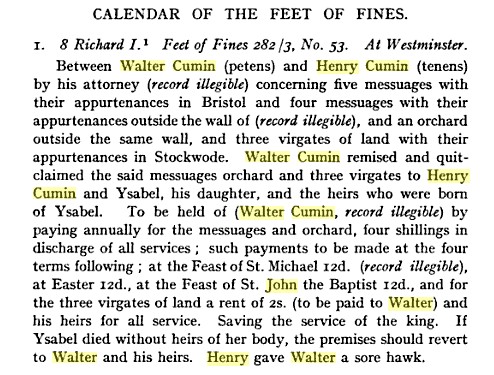
Snitterfield - is a village and civil parish in the Stratford on Avon district of Warwickshire, England,
Snitterfield was spelt as Snitfield. At the time of the Norman conquest of England Snitefeld was held by Saxi who also possessed land at Walton, Charlecote, Bramcote, Dorsington and Werlavescote but by 1086 it was held by the Count of Meulan; "in Ferncombe Hundred, Snitefeld.
Sort of related "Strongbow's Dad Richard Fitz Gilbert de Clare, origin and the relationship to the Crusades and Mary Magdalene and the Cathars ( the crusade against the Cathars begins around 1200 but before then all these Mary Magdelene priories and Hospitals are put up by returning Norman crusaders ) Also the Outlawe's seems to be associated with "Pembroke"
Richard de Clare, 2nd Earl of Pembroke - Lord of Leinster, Justiciar of Ireland (1130 – 20 April 1176). Like his father, he was also commonly known as Strongbow (French: Arc-Fort). He was a Cambro-Norman lord notable for his leading role in the Norman invasion of Ireland. ... Richard was the son of Gilbert de Clare, 1st Earl of Pembroke and Isabel de Beaumont. Richard's father died when he was about eighteen years old and Richard inherited the title Earl of Pembroke. It is probable that this title was not recognized at Henry II's coronation
| - - - - -
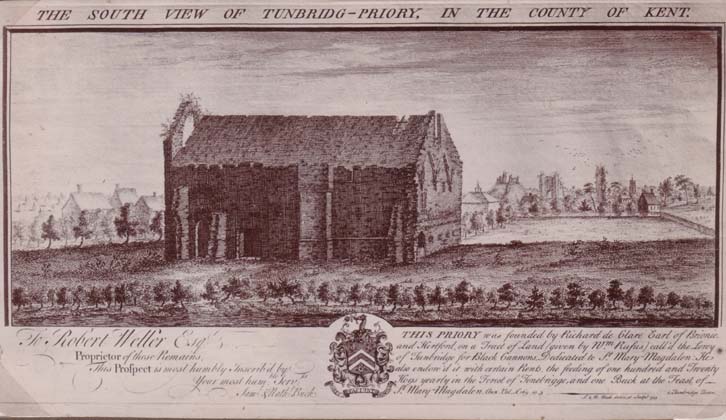 Tonbridge Priory
- was a priory
in Tonbridge,
Kent, England
that was established in 1124. It was destroyed by fire in 1337 and then
rebuilt. The priory was disestablished in 1523.
Tonbridge Priory
- was a priory
in Tonbridge,
Kent, England
that was established in 1124. It was destroyed by fire in 1337 and then
rebuilt. The priory was disestablished in 1523.
Tonbridge Priory was established in 1124 by Richard Fitz Gilbert de Clare, who held Tonbridge Castle.[1] He was buried in the priory following his death in 1136.[2] In 1139, a Papal bull was issued by Pope Celestine III. The priory was granted two cartloads of wood daily and the right of pannage for 120 pigs.[1] A buck was to be provided every year for the Feast of St Mary Magdalene.[3] In 1291, income for the priory amounted to almost £52 from properties located in East Anglia, Kent, Surrey and Sussex.[1] The priory enjoyed these rights until the forest of Tonbridge was forfeited to the Crown. King Richard II ordered that the priory should continue to enjoy the rights, although the right of pannage was reduced to 60 pigs.[2]
The priory was dedicated to St. Mary Magdalene. It was an Augustinian priory which had a range of buildings including a chapter house, church, dormitory, library, refectory and vestry.[4] In 1267, the priory was granted possession of the parish church in Tonbridge.[5] A Christmas feast during the reign of King Edward I consisted 2 quarters of beef, 3½ casks of beer, 200 loaves of bread, six cockerels, two hams, 100 herrings, two pigs and some wine,[1] at a cost of 16s 9½d.[6]
On 11 July 1337, the priory was destroyed by fire. It was rebuilt with assistance from the Bishop of Rochester and the Archbishop of Canterbury, who granted to the priory the right to take over the revenues of the church and vicarage at Leigh,[4] which was then worth £12 per annum
| - - - -
Richard Fitz Gilbert de Clare - (died 15 April 1136) was a Norman nobleman, the son of Gilbert Fitz Richard de Clare and Adeliza de Claremont. He founded the priory of St, Mary Magdalene, Tonbridge.
| - - - -
Gilbert de Clare, 1st Earl of Pembroke - Gilbert fitz Gilbert de Clare (c.1100 – 6 January 1148), son of Gilbert Fitz Richard and Alice de Claremont, was sometimes referred to as "Strongbow", although his son is better remembered by this name, was the first Earl of Pembroke from 1138.
| - - - - - -
Gilbert Fitz Richard - (died 1114/7) was son and eventual heir of Richard Fitz Gilbert of Clare and heiress Rohese Giffard. He succeeded to his father's possessions in England in 1091; his brother, Roger Fitz Richard, inherited his father's lands in Normandy. Gilbert's inheritance made him one of the wealthiest magnates in early twelfth-century England. He was the earl of Hertfordshire, but references rarely indicated the county; he was consistently called Earl Gilbert or Gilbert earl of Clare.
Gilbert may have been present at the suspicious death of William II in the New Forest in 1100. He was granted lands and the Lordship of Cardigan by Henry I, including Cardigan Castle. He founded the Cluniac priory at Stoke-by-Clare, Suffolk.
He married Adeliza/Alice de Claremont, daughter of Hugh, Count of Clermont, and Margaret de Roucy. She remarried one of the sons of Hervé de Montmorency after his death. Gilbert and Adeliza had at least eight children:
| - - - -
Richard fitz Gilbert - (bef. 1035 – c.1090), was a Norman lord who participated in the Norman conquest of England in 1066, and was styled "de Bienfaite", "de Clare", and "de Tonbridge" from his holdings.[1][2].
According to the medieval chronicler Gerald of Wales, the first of this great family, Richard de Clare, was the eldest son of Gilbert, surnamed Crispin, Count of Brionne, in Normandy. This Richard fitz-Gilbert came into England with William the Conqueror, and received from him great advancement in honour and possessions
He was rewarded with 176 lordships and large grants of land in England, including the right to build the castles of Clare and of Tonbridge. Richard fitz Gilbert received the lordship of Clare, in Suffolk, where parts of the wall of Clare Castle still stand.[5] He was thus Lord of Clare. Some contemporaneous and later sources called him Earl of Clare, though many modern sources view the title as a "styled title".
He served as Joint Chief Justiciar in William's absence, and played a major part in suppressing the revolt of 1075
| - - -
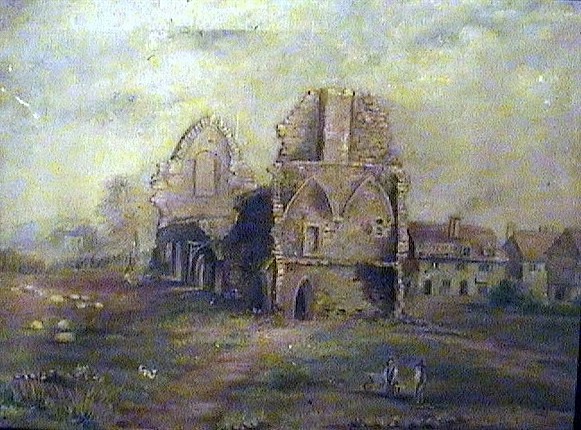 Tonbridge Collectables -
Tonbridge Priory - The tale is that the heart of Richard de Clare the owner of the castle in the reign of Henry lll 1216 -1272 was said to be buried in the priory.
Tonbridge Collectables -
Tonbridge Priory - The tale is that the heart of Richard de Clare the owner of the castle in the reign of Henry lll 1216 -1272 was said to be buried in the priory.
...
The ruins of the St Mary Magdalene stood on the land between Vale road and Priory road which
is now a car park. These ruins were demolished in 1842 to make way for the railway. A plea to the Railway Company was made to preserve the ruins but this was rejected
...
Finally we reached Somerhill House, a large beautiful Jacobean Mansion built around 1600’s now a school.
After walking around the house we came to the gardens and there it was the stone coffin was still there with a large cross carved on the lid. (No that's a typical Templar Sword cross!!! there are many examples of this typical Templar stone coffin)
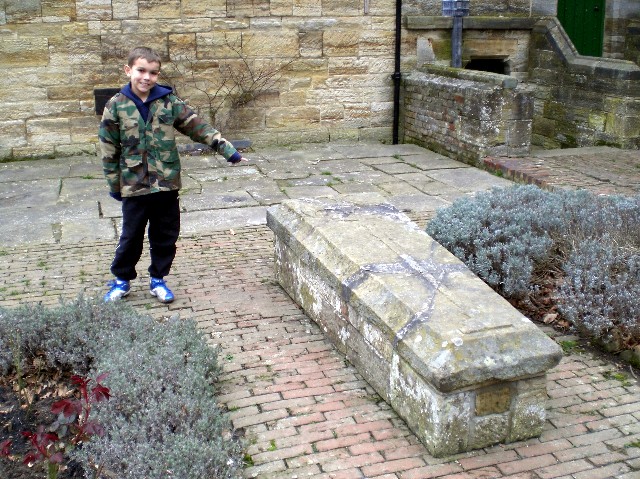
 Roger de Mowbray's Tomb - 1188
Roger de Mowbray's Tomb - 1188
Very exciting - Geat's - Wuffing Utlage evidence: Rune stone, Ballstorp, Edsvära, Västergötland, Sweden
700~1000AD - Útlagi placed this stone in memory of Sveinn -Rune sm103 - Småland
990~1010AD - Utlage raised this stone in memory of Eyvindr, a very good thegn - Ballstorp, Edsvära, Västergötland, Sweden
English: Men at a rune stone (Vg 62) in Ballstorp, Edsvära.
The inscription says:
"Utlage
raised this stone in memory of Öjvind, a very good thegn".
A "thegn" might be a peasant proprietor, yeoman or a warrior .
Parish (socken): Edsvära
Province (landskap): Västergötland
County (län): Västra Götaland
Rune stone, Ballstorp, Edsvära, Västergötland, Sweden
Flickr Swedish National Heritage Board's Photostream
Västergötland - There are many ancient remains in Västergötland. Most prominent are probably the dolmens from the Funnelbeaker culture, in the Falköping area south of lake Vänern. Finnestorp, near Larv, was a weapons sacrificial site from the Iron Age.[3]
The population of Västergötland, the Geats appear in the writings of the Greek Ptolemaios (as Goutai), and they appear as Gautigoths in Jordanes' work in the 6th century.
The province of Västergötland represents the heartland of Götaland, once an independent petty kingdom with a long line of Geatish kings. These are mainly described in foreign sources (Frankish) and through legends. It is possible that Västergötland had the same king as the rest of Sweden at the time of the monk Ansgar's mission to Sweden in the 9th century, but both the date and nature of its inclusion into the Swedish kingdom is a matter of much debate. Some date it as early as the 6th century, based on the Swedish-Geatish wars in Beowulf epos; others date it as late as the 12th century.
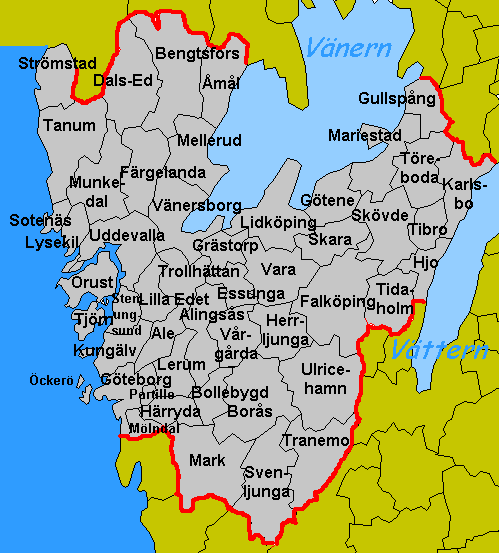
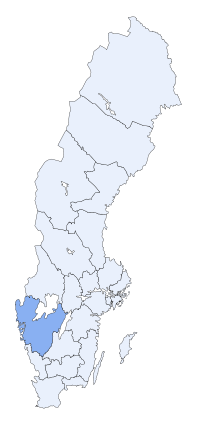
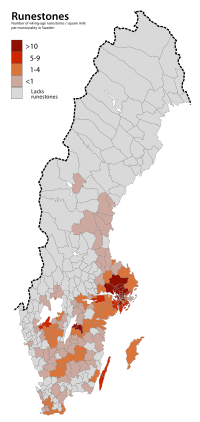 Runes in Sweden
Runes in Sweden
Rune stone, Ballstorp, Edsvära, Västergötland, Sweden Flickr -... (via Instant Mobilizer)
Here is how the rune stone looks today.: Vg 62 - Västergötland Ballstorp, Edsvära
Runestone - is typically a raised stone with a runic inscription, but the term can also be applied to inscriptions on boulders and on bedrock. The tradition began in the 4th century, and it lasted into the 12th century, but most of the runestones date from the late Viking Age. Most runestones are located in Scandinavia, but there are also scattered runestones in locations that were visited by Norsemen during the Viking Age. Runestones are often memorials to deceased men.
Runestones were usually brightly colored when erected, though this is no longer evident as the color has worn off.
| - - - -
Runic Dictionary inscription Vg 62 - (link page contains a map) - Rundata
period/dating: V - V, meaning Viking
Age, which is very broad spanning the late 8th to 11th centuries
style group: RAK -- ca. 990-1010 AD
english: Útlagi raised this stone in memory of
Eyvindr, a very good
Thegn.
Interstingly Eyvindr was a name used by a man of court to the King of Norway Haakon I of Norway in the time period and notice that Oslo is not too far away and the time period is correct, and there is a connection to England's King Athelstan - Eyvindr Skáldaspillir :
Haakon I of Norway - (c. 920–961), given the byname the Good, was the third king of Norway and the youngest son of Harald I of Norway and Thora Mosterstang
King Harald determined to remove his youngest son out of harm's way and
accordingly sent him to the court friend, King Athelstan
of England. Haakon was fostered by King Athelstan, as part of a peace
agreement made by his father, for which reason Haakon was nicknamed Adalsteinfostre.[2]
The English king brought him up in the Christian
religion. On the news of his father's death King Athelstan provided Haakon
with ships and men for an expedition against his half-brother Eirik
Bloodaxe, who had been proclaimed king.
...
Haakon I was frequently successful in everything he undertook except in his
attempt to introduce Christianity,
which aroused an opposition he did not feel strong enough to face. So entirely
did even his immediate circle ignore his religion that Eyvindr
Skáldaspillir, his court poet,
composed a poem, Hákonarmál,
on his death representing his welcome by his ancestors' gods into Valhalla.
Eyvindr Skáldaspillir - was a 10th century Norwegian skald. He was the court poet of king Hákon the Good and earl Hákon of Hlaðir. His son Hárekr later became a prominent chieftain in Norway.
His preserved works are:
Eyvindr drew heavily on earlier poetry in his works. The cognomen skáldaspillir means literally "spoiler of poets" and is sometimes translated as "plagiarist", though it might also mean that he was better than any other poet. He's mentioned in the second verse of the Norwegian national anthem.
| - - - - - - -
Runic Dictionary manuscripts search Utlag
Runic Dictionary inscription Sm 103 - Now this is in Wulfing territory:
Sweden:
Småland
Location: Rösa, Skede sn, Östra hd;
period/dating: V - V, meaning Viking
Age, which is very broad spanning the late 8th to 11th centuries
(700-1000AD)
english: Útlagi placed this stone in memory of Sveinn
The small lands of Småland. The black and red spots indicate runestones. The red spots indicate runestones telling of long voyages.
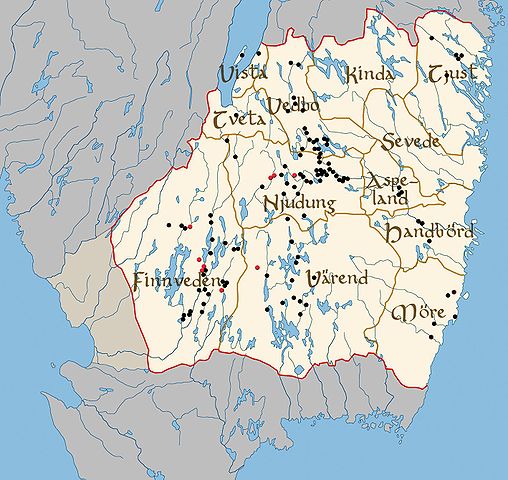 Småland
- is a historical province
(landskap) in southern Sweden.
Småland borders Blekinge,
Scania or Skåne,
Halland, Västergötland,
Östergötland
and the island Öland
in the Baltic
Sea. The name Småland literally means Small Lands.[2]
The latinized
form Smolandia
has been used in other languages. The highest summit in Småland is Tomtabacken
with its 377 m
Småland
- is a historical province
(landskap) in southern Sweden.
Småland borders Blekinge,
Scania or Skåne,
Halland, Västergötland,
Östergötland
and the island Öland
in the Baltic
Sea. The name Småland literally means Small Lands.[2]
The latinized
form Smolandia
has been used in other languages. The highest summit in Småland is Tomtabacken
with its 377 m
...
The name Småland ("small lands") comes from the fact that it was a
combination of several independent lands, Kinda (today a part of Östergötland),
Tveta, Vista, Vedbo, Tjust,
Sevede, Aspeland, Handbörd, Möre,
Värend, Finnveden
and Njudung. Every small land had its own law in the Viking age and early
middle age and could declare themselves neutral in wars Sweden was involved in,
at least if the King had no army present at the parliamentary debate. Around
1350, under the king Magnus
Eriksson a national law was introduced in Sweden, and the historic provinces
lost much of their old independence.
The city of Kalmar is one of the oldest cities of Sweden, and was in the medieval age the southernmost and the third largest city in Sweden, when it was a center for export of iron, which, in many cases, was handled by German merchants... IKEA was also founded in the Småland city of Älmhult
8_001_019 Sutton Hoo-The Evidence of the Documents By J. L. N. O'LOUGHLIN - Bjorkman, while in no doubt that the Wylfings were to be localized in southern Sweden, hazarded the conjecture that, if the Wylfings were not, in fact, Geats (Gotar}, their most probable home was in Blekinge. He then identified them with the Gothic Wulfings, the Heruli, who were known to have settled in southern Sweden, in Blekinge or in southern Smaland, on their return from southern Europe.
Götaland - Gothia, Gothland,[1][2] Gothenland, Gautland or Geatland is one of three lands of Sweden and comprises provinces.... Götaland once consisted of petty kingdoms, which its inhabitants called Gautar in Old Norse. It is generally agreed that these were the same as the Geatas, the people of the hero Beowulf (8th–11th century) in England's national epic by the same name.
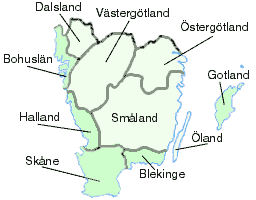 Blekinge
- is one of the traditional provinces
of Sweden (landskap), situated in the south of the country. It
borders Småland,
Scania and the Baltic
Sea. It is the country's second-smallest province by area (only Öland
is smaller), and the smallest province located on the mainland.
... Blekinge became part of the kingdom of Denmark
at some point in the early 1000s - most likely 1026.
Its status before then is unknown
Blekinge
- is one of the traditional provinces
of Sweden (landskap), situated in the south of the country. It
borders Småland,
Scania and the Baltic
Sea. It is the country's second-smallest province by area (only Öland
is smaller), and the smallest province located on the mainland.
... Blekinge became part of the kingdom of Denmark
at some point in the early 1000s - most likely 1026.
Its status before then is unknown
| - - - - -
Östergötland - The traditions of Östergötland date back into the Viking age, the undocumented Iron Age, and earlier, when this region had its own laws and kings (see Geatish kings and Wulfings). It is said that the famous Viking warrior Beowulf may likely have been from what is now the Östergötland region. The region kept its own laws, the Östgötalagen, into the Middle Ages. Östergötland belonged to the Christian heartland of the late Iron Age and early medieval Sweden. The Sverker and Bjälbo dynasties played pivotal roles in the consolidation of Sweden.
The province has about 50,000 ancient remains of different kinds. Some 1,749 are, for instance, grave fields
Concentrating on the Bristol - Somerset County history:
1186~1202 - Confirmation
by the Prior of St. James's, Bristol, to John, son of Ralph
Utlage, of land in Lewin's Mead
1200~1210 - Grant
by the Prior of St. James's, Bristol, to Margam Abbey, of land in Lewin's
Mead, Bristol, Formerly held by John, son of Ralph le Utlage
| - - - -
Berwick-upon-Tweed - is a town in the county of Northumberland and is the northernmost town in England, on the east coast at the mouth of the River Tweed. It is situated 2.5 miles (4 km) south of the Scottish border.
Burton upon Trent - is a town straddling the River Trent in the east of Staffordshire, England.
Full text of Calendar of the Patent Rolls Preserved in the Public Record Office Edward III
1310 - Nov 28
page - 290
1310 - Roger le Utlaghe - divers messuages in Burton-on-Trent - Nov 28 - Edward III
Pardon to the abbot and convent of Burton-on-Trent for acquiring in fee,
without licence in mortmain from the late king, divers messuages in
Burton-on-Trent from Roger le Utlaghe, Richard Cobard, and Emma
daughter of Hugh le Pestur, and also one acre of land in Calvermedwe
from William Cobard. By fine of 2 marks.
1310 - Roger le Utlaghe messuages in Burton-on-Trent - Nov 28 1310 - 4 Edward II - Burton upon Trent - Staffordshire, England - Letters patent of Edward [II] granting pardon to the Abbot and Convent of Burton for breach of the Statute of Mortmain in respect of various properties in Burton upon Trent - Property: messuage in Burton from Roger le Utlaghe, another from Richard Cobard, a third from Emma filius Hugonis le Pestur, all in Burton, and an acre of land in Calvermedwe from William Cobard.
1313 - Willielmus Outlagh - The Tallage of 6 Edward II - Bristollia Bristol - Tallage - Bristollia or, memoirs of the city ... - Gloucestershire - Bristol
1390 - ... in favour of Richard Bedewynde of Redynge 'hosteler'
and John Hosteler 'that was Richardes servant Bedewynde' of Redynge at suit of John
Outlawe of Bristol for ...
1392 - Simon
Outelawe, Michael Brailes plaintiffs - 1392 Sept. 29.-Oct. 5] York
- Premises: 9 messuages, 18 shops in Bristol and suburbs
1454 - Protection
to John Owtelawe in the retinue of John earl of Worcester - Oct 23
- 33 Henry VI - French Rolls - John
Tiptoft, Earl of Worcester - "the butcher of England" - in
1449 Lord
High Treasurer and then as Lord
Deputy of Ireland (1456–1457) - King
Henry VI's seizure with madness, in August 1453, supplied York with an
opportunity of getting control of the government without the use of force
against the King. ... the lords came up to London, early in 1454, with great
retinues
1533 - Adam Owtlawe, 'maryner' - St. Mary Matfelon - London Fines Henry VIII - Easter Anno 25 - St Mary Matfelon - church, popularly known as St Mary's, Whitechapel
1541 - Adam
Owtlawe - (£30) - '1541 London Subsidy roll: Tower Ward
1542 - Simon
Owghlawe owns land in Upton, afterwards possessed by Thomas Clere, 1542.
Thomas Clere
also had land here which formerly belonged to John Reynes of Acle. — Court of
Wards and Liveries, vi. 129.
1542 - Simon
Owghlawe - Outlawe -
land in Acle, Mowton, Boyton, Northbyrlyngham Fysshely and Upton
1543 - Adam
Owtlawe - send four ships to the Downes - Feb 23 - Sir Francis
Bryan to the Kings Council - Scotch prisoners - (Sir
Francis Bryan was a distinguished diplomat,
soldier, sailor,
cipherer, man
of letters, and poet.)
(Henry VIII)
1544 - July
1544 Expedition to Calais - Captain Adam Owtlawe
1544 - Ships
The Newe Barke 160 t., 120 m., Adam Owtlawe. (fn. 7) - Caleis
- Greate Shalop (D.), Oct 29 1544
1544 - Ships
- Great Shallop of Dover (Adam Owtlawe, c) - Cavendishe Shallopp
(Adam Owtlawe, c.) November 28 1544
1544 - Owtlawe,
Adam, [no place] 21 pynnyng - Prerogative Court of Canterbury - Probate
Wills page 397 - Adam Owtlawe's Will
1548 - Thomas Outlawe - King Edward VI. issued a proclamation, Oct. 1548 - accused of piracy - 300 crown reward
" They must know that p. and f. I W. prior of St. James of Bristol, and the brethren of that place authority and the retirement of our venerable father, Alan Theokesbirie [ Tewkesbury ] abbot and convent of that place granted and confirmed this Charter. John, son of Ralph Outlawe. Leowini the whole of that land in the meadow. Ralph his father had bought from the Ailwardo weaver (textore). "
Well lets look at that name Ailwardo ... that is AILWARD and/or AYLWARD : and I have found that Bristol/Ireland connection
"Ailward Juvenus, a merchant from Bristol, who was granted extensive lands in Ireland by Henry II, probably for his help with Henry's invasion of 1172" so this may have been the Ailwardo were looking for :
AYLWARD
- The AYLWARD name is derived from the old English name Aethelward, meaning "noble protector" (cf the modern
"adel vaardare" in Swedish (a wuffing connection?)). It is of patronymic origin - that is it is derived from a personal name.
The "original" Aethelward is, presumably, the one in the Encyclopaedia Britannica who was one of the noble family of
Wessex, and a near descendant (his nephew I believe) of King Alfred of burnt cakes fame.
It is not a very common name, except in certain parts of Ireland. The Aylward shield represents the Irish branch, who are all usually descended from
Ailward Juvenus, a merchant from Bristol, who was granted extensive lands in Ireland by Henry II, probably for his help with Henry's invasion of 1172. The lands include an area in the South-east called
Aylwardstown - very difficult to find (its now mostly a cattle farm). In County Kilkenny there is also another area that has a lot of
Aylwards, and there is even a castle - Shankill Castle in Paulstown, that was owned by the Aylwards until the male line died out in the late 1800s. It was then owned by the Toler-Aylwards, who finally sold it in the late 1980s. [For information on Shankill Castle see "A guide to Irish County homes" by Mark Bence-Jones (Constance)].
You come across the Aylward (or Ailward) name quite commonly in mediaeval times. As an example, below is
the story of St Godric who is of the Ailward family
... One merchant, became Saint Goderic. This holy man's father was named Ailward, (I am Aylward) and his mother Edwenna (I am Edward) became a
saint....They
were born in
| - - -
Godric of Finchale - (or Saint Goderic) (c. 1065 – May 21, 1170) was an English hermit, merchant and popular medieval saint, although he was never formally canonized. He was born in Walpole in Norfolk and died in Finchale in County Durham, England.
Saint Godric's life was recorded by a contemporary of his: a monk named Reginald of Durham. Several other hagiographies are also extant. According to these accounts, Godric, who began from humble beginnings as the son of Ailward and Edwenna, "both of slender rank and wealth, but abundant in righteousness and virtue", was a peddler, then a sailor and entrepreneur, and may have been the captain and owner of the ship that conveyed Baldwin I of Jerusalem to Jaffa in 1102. After years at sea, Godric reportedly went to the island of Lindisfarne and there encountered Saint Cuthbert; this will not have been a physical encounter as Cuthbert had long been dead and was by then interred at Durham Cathedral. This encounter changed his life, and he devoted himself to Christianity and service to God thereafter.
After many pilgrimages around the Mediterranean, Godric returned to England and lived with an elderly hermit named Aelric for two years. Upon Aelric's death, Godric made one last pilgrimage to Jerusalem, and then returned home where he convinced Ranulf Flambard, the Bishop of Durham, to grant him a place to live as a hermit at Finchale, by the River Wear....
| - - - The Aylward
name in Bristol : ]
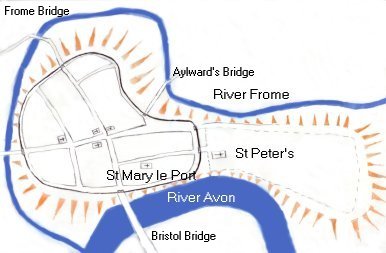 ...
...
From Æthelweard Mæw to Beorhtric
After the deaths of Æthelred (911) and Æthelflaed (918), Mercia lost even a semblance of independence from Wessex. Alfred's son Edward the Elder was King of England. The idea of separate kingdoms re-emerged in 955, when
Edwy succeeded to Wessex and his brother Edgar to Mercia, but after the death of Edwy in 959, Edgar ruled all
England.41 The Avon became the boundary between the shires of Gloucester and Somerset, rather than between kingdoms.
This helps to explain how a scion of the House of Wessex came to be lord of
Bristol. We have to piece together the story from confusing scraps of information. According to a local inquiry in 1318,
Bristol belonged before the Conquest to Aylward Mean and his son Bristric.
42 . Though the names and the relationship are mangled, these are real people. The founder's book of Tewksbury
Abbey, compiled in 1476 from earlier sources, provides another piece of the puzzle. It tells us that:
About the year 930, in the reign of King Athelstan, flourished a certain noble knight sprung of the illustrious stock of Edward the Elder and known by the name of
Haylward Meaw on account of his fair colouring. This man being strenuous in arms, powerful in honours and steadfast in faith, and not unmindful of his end, built for himself and Algiva his wife in the days of
King Ethelred and St. Dunstan the archbishop a small monastery on his lands at Cranborne and granted it possessions... He made Tewkesbury Priory, of which he was patron, wholly subject to it.
These things were done about the year 980. And Haylward, having died and received burial in the church which he had built, was succeeded by his son by Algiva, lord Algar, father of Britric, who according to the vow of his parents amplified the church which they had
begun.43
Again the tale is somewhat garbled, but we can translate Haylward Meaw into Æthelweard Mæw, the founder of Cranborne Abbey, Dorset, mother house of Tewkesbury Abbey, whose wife Ælfgifu and son Ælfgar made further grants to
Cranborne.44.
We shall see the connection between Bristol and Tewkesbury Abbey in the Norman period, but for the moment let us pursue this elusive family. The author of the founder's book would be on safe ground where he had monastic charters to work from, but the idea that Æthelweard Mæw flourished 50 years before his foundation of Cranborne Abbey is probably based on a misreading of 980 for 930, or perhaps a confusion with another Æthelweard; the date would make an implausibly long span for the three generations. Nor can we trust this late source on the reason for Æthelweard's nickname. Mæw meant "seagull". This seemed so unlikely to later writers that they transformed it into more comprehensible nicknames. The 19th-century edition of Dugdale's Monasticon edited the name as "Snew", possibly under the influence of Bristol historian Samuel Seyer, who explained that this was the local pronunciation of "snow", which made more sense to him as a name meaning fair.45
. Whatever the genesis of the name, it reveals nothing of Æthelweard's parentage. Yet the royal ancestry claimed for him seems plausible, since his grandson
Beorhtric (often written Britric) was a notable magnate in the time of Edward the Confessor, holding over 350 hides of land in Cornwall, Devon, Dorset, Gloucestershire, Wiltshire and
Worcestershire.46
The Viking menace returned in the reign of Æthelred, this time better organised and more powerful than before. By right of conquest
Sweyn of Denmark made himself king of England before his death in 1014. There followed a desperate attempt by the English to regain an English king. At this point Ælfgar, son of Meaw, turned traitor. He followed Eadric Streona, Ealdorman of Mercia, in joining the Danish army under Cnut against Edmund Ironside in
1016.47 We shall never know his reasons, but he certainly ended up on the winning side. Further turbulence followed the death of Cnut in 1035, but
it would seem that Ælfgar and his son Beorhtric weathered the storms with their patrimony intact until the Norman Conquest.
Since Bristol is given only a glancing mention in The Domesday Book, it is naturally not listed among the pre-Conquest manors of Beorhtric (or anyone else), but we can trace a connection.
Many of the lands of Beorhtric were given to Queen Matilda after the Conquest. The founder's book of Tewkesbury Abbey accounts for this by a romantic story taken from Norman chronicles, which may or may not have the slightest truth in it:
Matilda the wife of the Conqueror hated the said Brihtric Meaw because when sent abroad on an embassy for the affairs of the realm he refused her hand in
marriage. She afterwards married William, and having sought opportunity stirred up the king's wrath against the Saxon nobleman so that he was seized by the king's order in the manor of Hanley and conveyed to Winchester, where he died and was buried leaving no
heir.48 Hanley Castle, Worcestershire, formed part of the manor of
Tewkesbury:
After the queen's death the former estate of Beorhtric formed the Honour of
Gloucester,49. to which Bristol was certainly attached (see below). So it is
almost certain that Beorhtric held Bristol, which makes it quite credible that the town
was also held by his grandfather Æthelweard Mæw. This would be the walled burh.
If Bristol became a planned town in the reign of Alfred, then Æthelweard Mæw could have gained Bristol anything up to a century later. It is therefore plausible that he was responsible for another entrance to the town which appears to be a later addition to the plan and bears his name.
In Saxon planned towns, main streets lead to the main town gates and so they did in Bristol. By contrast
Aylward's Gate lay off the north-eastern intramural lane now Tower Lane. It gave access to Pithay, formerly known as
Aylward's Street, which led to Alyward's Bridge over the
Frome.50 . Aylward is certainly found as a Bristol surname in the 13th century, when Aylward's Bridge is recorded.
However a town gate and bridge are more likely to be constructed by a town authority, in this case its Saxon
lord.
The manor of Barton Regis was held by King Edward the Confessor; it presumably included St Peter's Church and the extra-mural settlement around it which has left traces in the archaeological record. The lands of Edward came into the hands of William I at the Conquest, which meant that the king had a convenient site for a Norman castle east of St Peter's, guarding the entrance to the town. Elsewhere the Normans did not hesitate to raze large areas within walled towns in order to create castles. However that was destructive of future revenues and there was no reason to do so here.
Bristol and the Honour of Gloucester
Queen Matilda died in in 1083, 51The Anglo-Saxon Chronicle so at the time of the Domesday survey in 1086 her former estates were in the hands of the Crown, which would explain why the chief revenues of Bristol were at that point being paid to the king along with his income from Barton Regis.52Domesday Book: Gloucestershire ed. J.S.Moore (1982), 1,21. William II used his mother's lands to form the Honour of Gloucester, which he granted to Robert Fitz-Hamon, as a reward for his loyalty.53G.E.C., The Complete Peerage, new edn. ed. V. Gibbs and H.A. Doubleday, vol. 5 (1926), p. 683. One of the most important manors of this great estate was
Tewkesbury. There Fitz-Hamon, under the influence of his wife Sibilla, rebuilt the monastery which had been a cell of Cranborne Abbey to such good effect that the monks of Cranborne were able to move to Tewkesbury in 1102, leaving Cranborne as a dependent cell. Fitz-Hamon also increased the endowment of what had become Tewkesbury Abbey.54 Victoria History of the County of Gloucester, vol. 2 (1907), p. 62. Among his gifts and those of his chaplain were St Peter's Church, Bristol, with all that pertained to it within and without the town and a tithe of the lordship revenues of Bristol.55 Calendar of Charter Rolls vol. 2, p. 490; Bristol Record Office 5139/238, published as The Earldom of Gloucester Charters ed. R.B. Patterson (Oxford 1972), p. 161, no.179. Here is evidence that Fitz-Hamon held both the town and castle of Bristol.
Fitz-Hamon's heir was his daughter Mabel, who brought the Honour of Gloucester to her husband Robert, illegitimate son of Henry I.
In 1121 Robert was created Earl of Gloucester. The revenues of Bristol were the largest item in the earl's
income.56. Robert continued his father-in-law's patronage of Tewkesbury Abbey. About 1137 he founded the Priory of St. James at Bristol as a dependent cell of Tewkesbury. It would be easier for the priory than its more distant mother house to administer the property within Barton Regis which had once belonged to St Peter's Church. So it is not surprising that we find among the possessions of the priory at the Dissolution the rectories of Stapleton, Mangotsfield and SS Philip and Jacob, Bristol. The priory was subsequently sold together with its possessions including land in Stapleton, Mangotsfield and elsewhere in the Hundred of
Barton.57
Robert of Gloucester and his son William, 2nd Earl of Gloucester fought long and loyally for Empress Matilda during the civil wars that followed Henry I's death. Bristol became the foremost stronghold of resistance to King Stephen. Ironically their ultimate success led to the royal seisure of Bristol Castle. When Matilda's son came to the throne as Henry II, his policy was to protect his hard-won authority by destroying or controlling castles throughout his realm. Although Earl William managed to expel the royal garrison of Bristol Castle in 1174, he surrendered the castle in 1175 and it remained in royal custody thereafter, supported by the profits of Earl's
Barton.58
Conclusion
It would seem that the defended town of Bristol was an important part of an estate dating back to the 10th century, held until the Norman conquest by a minor branch of
the house of Wessex. Æthelweard Mæw probably gained Bristol by grant from one of his royal relatives, many years after the town was laid out.
The walled town probably formed part of the ring of defences around Wessex and Mercia created by Alfred the Great and his
children. However the extra-mural position of St Peter's Church suggests that there was an earlier settlement, perhaps dating from the late 8th century, fitting the pattern of Mercian proto-towns elsewhere.
What I find interesting is that the Ailward's like the Utlage's were pre-conquest Saxons (Anglo-Danish ?) and this Bristol merchant was elevated with grants. Also originally from Norfolk. Also possibly connected to St. Godric, who originally was a merchant from Kings Lynn , was a mariner in the Mediterranean , and assisted in the First Crusade . Perhaps the Utlage's did similar things.
1172 - Torsten utlag - Reginaldus utlag - Dublin Roll of Names
Ireland under the Normans - Goddard Henry Orpen - Volume 2
Ailward juvenis, 'the king's merchant,' page 274 volume I (see below)
| - - - - -
Ayl-ward = noble guardian in Old Saxon
Here is part of the history of the Aylward family that I got from an
article published around 1980 in a newspaper from Waterford.
AYLWARD
Saxon: AEDHELWEARD (NOBLE PROTECTOR)
IRISH Aiglehrt
The original home of the family, was
to the east of Waterford, in the parish of Faithlegg, where the first of the
Aylwards was granted a considerable estate by King Henry II. His descendants
held Faithlegg for nearly five hundred years, until like so many other great
Irish families, they were sent by Crowwell “to hell or Connaught”.
As the Aylwards came over to
Ireland with Henry II, it is usually assumed that they were a Norman family.
Actually, they were Saxon in origin, and they had been in England for
centuries before the Normans arrived there. The name “Aylward” comes from
the Saxon “Aedhelweard” and means “Noble Protector”. It was quite a
common Christian name in Saxon England. As a surname, it is still
occasionally met with over there.
The Irish Aylwards are descended from a Bristol merchant and ship-owner named Aylward Juvenis (Aylward the counger), who may well have provided King Henry II with some of the ships that took him to Ireland in 1171. In addition to his Irish descendants, he left sons who succeeded to his business in Bristol. The Bristol Aylwards took a leading part in the life of their city and they must have been important people, for Bristol was at that time, second only to London in importance. One of them, Roger Aylward was one of the merchants whose job it was to import wines for use at the King’s table. His brother Richard was mayor of Bristol in 1239-40. There was an Aylward Street and an Aylward gate named after the family in Bristol. The Bristol Aylward died out with the death of John Aylward, merchand and ship-owner in 1427.
It was at the Great Council of
Oxford in 1177 that Henry II granted Faithlegg to Aylward Juvenis. He made
several grants of land in Ireland to his chief followers at this council,
including the grant of County Waterford to Robert le Poer, ancestor of the
Powers, who was the king’s marshal. Aylward must have been an important
man to be included in such exalted company.
John's first expedition to Ireland
The 1185 expedition of the future King John of England to Ireland has attracted much historical debate due to the lack of government records available and the subsequent reliance on sources such as the Irish Annals and the writings of Gerald of Wales.
The subject of John going to Ireland first came into question under the reign of his father, Henry II specifically with the Council of Oxford in the year 1177. This council agreed to have John made King of Ireland. This would appear to have been a strategy of his father's to divide his Angevin possessions between his four sons. The approval of Pope Alexander III was sought to have John crowned King of Ireland. Disagreements with first Alexander III and then his successor Pope Lucius III caused this to be delayed and instead John went as only Lord of Ireland.
In 1184 arrangements were made for John's departure with the sending of John Cumin and Philip of Worcester to prepare the ground for John's arrival. John arrived in Ireland in April 1185, landing at Waterford with around 300 Knights and numerous foot soldiers and archers.
Oxford, Council of - Oxford, Council of (May 1177). Following the death in 1176 of Richard fitz Gilbert, alias Strongbow, lord of Leinster, administration of his lands became the responsibility of the English crown during the minority of his heirs. At the Council of Oxford Leinster was divided into three areas centred on Dublin, Waterford, and Wexford, to which royal administrators were assigned. Henry II also designated his son John ‘lord of Ireland’ and made speculative grants of the kingdom of Cork (Desmond) to Robert fitz Stephen and Miles de Cogan, and of Limerick (Thomond) to Philip de Braose.
Internet Archive Search IRELAND UNDER THE NORMANS
Ireland under the Normans _Volume I
268 HENRY II IN IRELAND
The first We have one authentic memorial of Henry's Charter, stay in Dublin, namely,
the first Dublin charter, the original of which, executed in Dublin in the winter of 1171-2, is still preserved in the
municipal archives. By this charter Henry granted to his men of Bristol (Bristowa) his city of Dublin
(Duvelina), to be inhabited, together with all the liberties and free customs which they had at
Bristol and throughout his entire land. 1 By a subsequent charter, executed probably in 1174
at St. Lo, in Normandy, Henry granted to ' his burgesses of Dublin ' (i. e. whether men of Bristol
or not) freedom from various tolls and duties throughout his lands. In 1185 John confirmed
to his men of Bristol his father's grant, and in 1192 gave to the citizens of Dublin an extended
charter similar to that granted by him to Bristol in 1188.
HENRY II IN IRELAND 269
It was clearly necessary to replenish the city, and Henry's selection of Bristol, the
third city in England, as the source for the new colony, probably contributed to the commercial
success of Anglo-Norman Dublin. The merchants of Bristol were no strangers to Dublin,
and from no town in England could Dublin be so easily reached. Bristol had aided Henry's
expedition, and it was from the port of Bristol that supplies were sent to his
army.
274 HENRY II IN IRELAND
It appears also from a late enrollment 1 that in this year Henry granted the lands of Faithleg, near his landing-place at Crook in Waterford, to Ailward juvenis, as king's merchant, but we have no clear evidence of other grants out of the Crown lands at this time.
1 Chief Rememb. Roll, Dublin, 38 Eliz. (cited Lynch's Legal Institutions, p. 107). Ailward juvenis was probably son of Ailward the chamberlain, at this time in the young king's suite. Close to Faithleg Church is a Norman mote, and in what was the attached bailey stand the ruins of a later stone castle which belonged to the Ailwards up to 1690.
The English and the Normans Ethnic Hostility, Assimilation, and Identity. - Hugh M. Thomas
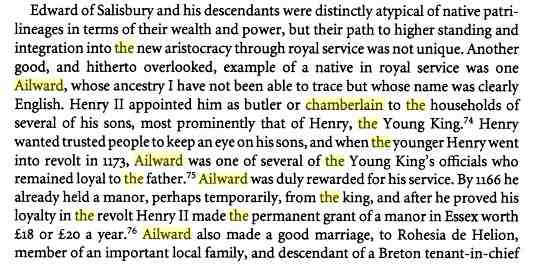
Ireland under the
Normans _VolumeII
Ireland under the Normans _ Volume III
Ireland under the Normans (Volume 4)
Dublin Charter From Henry II.—This is the oldest original Anglo-Norman document connected with Ireland now extant. By it Henry granted to his men of Bristol the city of Dublin, to be held from him with free customs and liberties similar to those of Bristol. The execution of this charter may be assigned to the period between November A.D. 1171, and the ensuing March, during which time Henry sojourned at Dublin. This highly important document is now preserved among the muniments of the city of Dublin. It is of small size, being only six-and-a-half inches in length, by five in breadth. A considerable fragment of the original seal, much discolored by age, is still attached to it.
Dublin Roll Of Names, Circa A.D. 1172.—This document, which I have styled
"Dublin Roll of Names," now consists of six parchment membranes, of about twenty inches in length by nine in width, written on both sides. The first of these surviving membranes contains
Dublin neither title nor heading, and bears traces of having been long carelessly treated. Portions of its front are discolored and obliterated, while its back has acquired a dark brown hue, and has been in some places rendered rough and illegible by friction.
This Roll formed the wrapper of a bundle of parchments which I found, in 1866, among the then un-arranged muniments of the Municipal Corporation of Dublin. The bundle contained several other membranes, which, from the style of the writing and the nature of the entries, appeared to be in sequence to the six membranes in which they were wrapped.
No entries specificatory of their age, class, or locality, are to bo found in
the six membranes ; but, from palseographic and other characteristics, I
assigned them to the latter part of the twelfth century. In this opinion I was
supported by the high authority of Sir T. Duffus Hardy, late Deputy Keeper of
the Public Records in England, who carefully examined the document with me. The
usual obscurity of members of ancient guilds, or civic communities, constituted
an impediment towards the establishment of the precise age of this Roll by
entries extant elsewhere in connexion with the individuals registered on it; and
few records of so early a period relating to Ireland now survive. However, through
independent external materials, chiefly in England, I succeeded in synchronizing
persons whose names are entered on the present
fifth and sixth membranes of this document with the early stages of Anglo-Norman
settlement in Ireland, in connexion with which it thus appears to be the
most ancient Roll extant. This result is supported by a partly torn heading of
the twelfth membrane, indicating the latter to be a Dublin Guild-Merchant Roll;
while on its fractured corner a name has fortunately survived which enabled me
to bring its date to the close of the twelfth century. A further confirmation of
this view is derived from the shattered heading of the fourteenth membrane; and
the succeeding membrane contains a full heading of the tenth regal year of Henry
III., A.D. 1226.
1172 - Torsten utlag - Reginaldus utlag - Dublin Roll of Names
Dublin Roll of Names [ 1172] Page 3
Page 6
Torsten utlag
Page 21
Reginaldus utlag
page 34
Radulfus de Britollo (Ralph Utlage of Bristol ?)
page 86 Dublin Guild Merchants 1226
Johannes Ailward de Bristoll
---- >>> Back to Outlawe Research Journal - Page 4